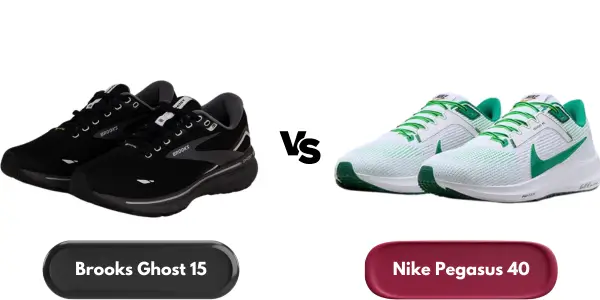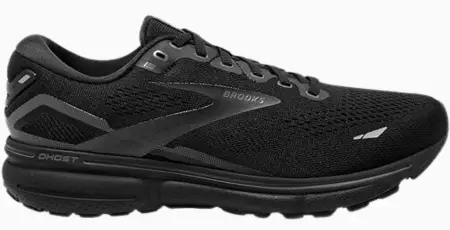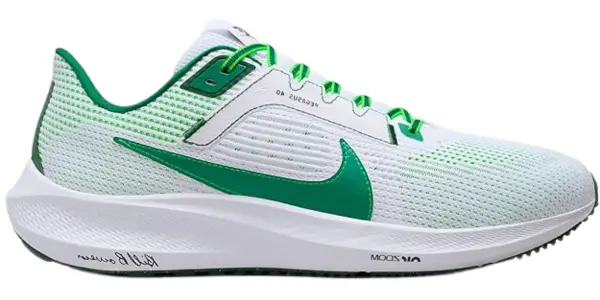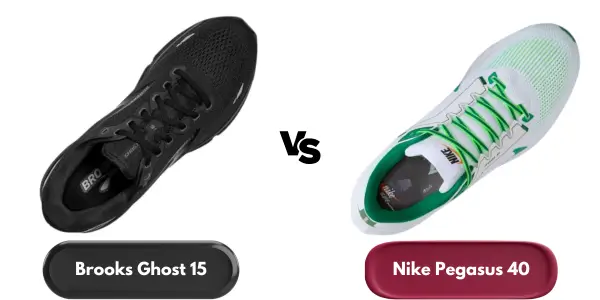Nike Pegasus vs Brooks Ghost: Running Shoes
Last Updated: January 01, 2025 | Author: Jake Thompson
Embarking on the quest to find the perfect running shoe can feel like navigating a labyrinth, with each turn presenting a new contender vying for your allegiance. At the heart of this maze, the Nike Pegasus 40 and Brooks Ghost 15 stand out, not just as mere options, but as legends in their own right.
Each offers a unique promise: the Pegasus 40, with its swift responsiveness, seems to whisper tales of speed and agility, however, the Ghost 15, renowned for its unmatched comfort, assures a journey where every step feels like floating on air.
The choice between them is more than a matter of preference; it's about discovering which shoe resonates with the soul of your run. As we delve deeper into the virtues and vices of these two titans, I invite you to lace up and join me on this exploration.
Let's uncover together which shoe among Nike Pegasus vs Brooks Ghost is the stellar running shoes that will elevate your running journey to new heights.

Table of Content:
- Key Takeaways
- Table: Nike Pegasus 40 vs Brooks Ghost 15
- Pros & Cons
- Nike Pegasus 40: The Evolution of a Legend
- Brooks Ghost 15: Reigning Supreme in Comfort
- Design and Build: Analyzing the Style of Pegasus vs Ghost
- Cushioning Battle: Which Among Nike Pegasus 40 and the Brooks Ghost 15 Offers the Ultimate Comfort?
- Battle of the Uppers: Mesh vs Breathability
- Outsole Showdown: Traction and Grip
- Performance Metrics: Maximizing Performance
- Responsive vs Plush: Which Midsole Wins the Race?
- Fit and Feel: Tailoring the Perfect Experience During Training
- Durability
- Final Verdict
- Frequently Asked Questions
Key Takeaways
- - Both the Nike Pegasus 40 and Brooks Ghost 15 offer neutral support with a 12mm heel drop.
- - The Pegasus 40 features a React foam midsole and Zoom Air units for responsiveness and a firmer ride.
- - The Ghost 15 uses DNA Loft v2 midsole for softer cushioning, making it ideal for longer runs.
- - Traction on the Pegasus 40 is superior, suitable for a variety of terrains, including slippery conditions.
Table: Brooks Ghost 15 vs Nike Pegasus 40

|

|
|
|---|---|---|
| Feature | Brooks Ghost 15 | Nike Pegasus 40 |
| Terrain | Road | Road |
| Pace | Daily running | Daily running |
| Toebox | Medium | Medium |
| Pronation | Underpronation | Supination |
| Arch support | Neutral | Neutral |
| Heel to toe drop | 12mm | 10mm |
| Weight | 286g | 275g |
| Cushioning | Plush | Plush |
| Breathable | ✓ | ✓ |
| Comfortable | ✓ | ✓ |
| Lightweight | - | ✓ |
| Maximalist | ✓ | ✓ |
| Orthotic friendly | ✓ | ✓ |
| Removable insole | ✓ | ✓ |
| Sockless wear | ✓ | ✓ |
| Distance | Long distance | Long distance |
| Widths available | Narrow, Normal, Wide, X-Wide | Normal, Wide, X-Wide |
| All-day wear | ✓ | ✓ |
| For beginners | ✓ | ✓ |
| Jogging | ✓ | ✓ |
| Treadmill | ✓ | ✓ |
| Walking | ✓ | ✓ |
| Strike Pattern | Heel strike | Heel strike |
| Forefoot/Midfoot strike | ||
| Collection | Brooks Ghost | Nike Pegasus |
| Nike React | ||
| Nike Air Zoom | ||
| Arch Type | High arch | High arch |
| Flexibility | Flexible | Very flexible |
| Material | Mesh | Mesh |
| Season | Summer | Winter |
| Release date | Nov 2022 | Apr 2023 |
| No of colorways | 101 | 147 |
| Forefoot height | 23mm | 23mm |
| Heel height | 35mm | 33mm |
| Price |
Pros & Cons
Brooks Ghost 15:
Pros:- - Comfortable cushioning.
- - Durable outsole.
- - Responsive midsole.
- - Breathable upper.
- - Wide range of sizes and widths.
- Slightly heavy.
- Some may find arch support lacking.
Nike Pegasus 40
Pros:- Versatile for daily training and speed work.
- Responsive Zoom Air cushioning.
- Lightweight and breathable design.
- Wide availability in colors and sizes.
- Durability concerns with outsole.
- Firm cushioning for some.
Nike Pegasus 40: The Evolution of a Legend
The Nike Pegasus line has always been a big deal among runners, and now with the Pegasus 40 out, it's even better. In my years of running marathons and helping others pick the best gear, I've seen a lot of shoes come and go. But the Pegasus 40? It's something special.
This shoe really shows how much Nike cares about making shoes better for runners. It's like they took all the good stuff from the older versions and made it even better. For instance, I remember running a particularly tough marathon in a rainy city. These shoes kept my steps light and bouncy, which is exactly what you need when you're trying to keep up your pace.
The cushioning in the middle of the shoe, which is super soft and springy, and the special air pockets near the front that help push you forward, are game-changers. It's like every time my foot hits the ground, these features help me bounce right back up and keep moving. This isn't just good for long races; it makes a big difference in short runs or sprints too.
It takes what runners have always loved and adds new stuff that meets our needs today. Whether I'm out for a casual jog or in the middle of a marathon, wearing these makes me feel like I'm part of a long line of runners.
Brooks Ghost 15: Reigning Supreme in Comfort
From my many runs and races, I've found these pair of running shoes stands out because they're super comfy. They've this special cushion in them that feels like you're running on clouds. It's not just soft; it also helps keep your feet steady and supported, which is great for runners like me who sometimes have our feet rolling inwards a bit too much when we run.
I've run in these shoes many miles, and they've held up really well. They don't get worn out quickly, which means I don't have to keep buying new ones all the time. They've a good grip too, so I feel secure running on different types of ground.
One time, during a really long race, when my feet usually start to feel sore, these shoes were a game changer. My feet felt supported and comfy from start to finish. They're not just about looking good; they're about making your runs feel good.
Design and Build: Analyzing the Style of Pegasus vs Ghost
When looking at two popular running shoes, I noticed something special about each. Among the Nike Air Zoom vs the Brooks Ghost, the Pegasus 40 has a special foam and air bubbles in the sole that make your feet feel light and bouncy, perfect for when I'm sprinting towards the finish line in a marathon. The Ghost 15 of the Brooks' is super cushy and stable, making my feet feel supported and comfy on long, slow runs.
From running countless races and helping folks pick out the best running gear, I've learned that the right shoe really depends on what kind of running you're doing. For instance, when I was training for my last marathon, the bouncy shoes were my go-to for speed days because they helped me push harder without feeling like my feet were dragging. But on my long, easy run days? I always reached for the cushy shoes. They made sure my feet didn't ache after miles and miles, which was a lifesaver.
Cushioning Battle: Which Among Nike Pegasus 40 and the Brooks Ghost 15 Offers the Ultimate Comfort?

I've run in many different shoes over the years, and two types have really stood out to me, especially when thinking about which ones keep my feet feeling good on long runs. One type has a special foam and air bubbles in the soles that make you feel a bit of a bounce with each step. This is great because it feels like the ground is pushing back a little, helping me run faster without my feet getting too tired. It's a bit like having a spring under your foot that gives you a little extra lift.
The other type of shoe I've tried has this really soft and cushy foam in it. Running in these feels like you're stepping on a very soft pillow with every step. It's super comfortable, especially on those longer runs when my feet start to feel the burn. This softness helps absorb the shock from hitting the ground, so my legs don't get as sore.
From my experience, choosing between these two depends on what you're looking for in your runs. If you like feeling speedy and want that extra 'zing' in your step, the first type with the bounce is a good pick. But, if you're all about keeping your feet as comfortable as possible, especially on those long distances, then the super cushy shoes might be the way to go.
I remember one marathon where I wore the bouncy shoes, and they really helped me keep up a good pace without wearing out my legs too quickly. Another time, I chose the extra cushy shoes for a really long training run, and my feet were thanking me by the end because they didn't hurt as much as usual.
Battle of the Uppers: Mesh vs Breathability
When looking at running shoes, I always pay attention to the top part, which is really important for comfort and performance. I've run in lots of shoes and I've found two types that stand out, though I won't mention their names. They both do a great job in different ways.
- - Mesh Design: One type has a special mesh that's really good at letting your feet breathe while keeping them snug and supported. The other type has a mesh that feels super soft and still lets lots of air in so your feet don't get too hot.
- - Support and Flexibility: The first type of shoe has materials that make sure your foot doesn't move around too much, which is great for both support and flexibility. The second type is more about giving you a comfy, flexible fit but still keeping your foot in place.
- - Breathability: Both shoes are awesome at keeping your feet from getting sweaty, but they go about it in different ways. One is a bit tighter but still comfy, and the other is softer and feels like it's hugging your foot.
From my experience, both shoes are great for running, but it really comes down to what feels best on your feet. I've had races where one type was just what I needed for a long, tough run, and other times when the softer feel was perfect for a shorter, faster race. It's all about trying them and seeing what works best for you.
Outsole Showdown: Traction and Grip
When picking the right shoes for running, I always look closely at the bottom part, which touches the ground. It's super important because it affects how well the shoe sticks to the ground, how it feels, and how long it will last. From my experience of running in all sorts of weather and on different paths, plus helping others find their perfect running shoes, I've learned a lot about what makes a shoe great.
One pair of shoes I've tried has a really thick and tough bottom. This means they can handle a lot of running on different types of surfaces, like trails, roads, and even gravel, without wearing out too fast. They provide a solid grip, so whether it's wet or dry, I feel confident that I won't slip.
Another pair I've used is a bit different. They mix two types of materials on the bottom, making them really good for running on streets and sidewalks. They're flexible and stick well to the pavement, which is great for quick turns or when dodging obstacles. But, they mightn't last as long if you're always running on rough trails because some parts are softer and can wear down.
In my runs, I've noticed that the first pair is awesome for when I'm exploring new routes that might take me off the beaten path. They've been super reliable, whether I'm on a forest trail or a rocky hillside. The second pair, though, is my go-to for my daily runs around the neighborhood or in the park. They feel light and quick on my feet, and the grip is just right for keeping me moving fast on smoother surfaces.
Performance Metrics: Maximizing Performance
When I compare running shoes, I really look into how they help with support and stability because these things make a big difference in how good your run feels. I dig into how the cushioning in the shoes works because you want something that's both springy and soft. This makes your run feel better and can help you do better. I also think a lot about how the shoes fit. They need to fit just right so your foot doesn't slide around, and they've to be comfortable for all kinds of runs.
From my own running, I've found that some shoes are just better for long runs because they keep my feet feeling good the whole time. And in races, I've noticed that the right shoes can actually make me run faster because they've the perfect mix of bounce and cushion. I always tell people at my store about these experiences because it helps them find the best gear for their runs. It's not just about the shoe, but how it works for you when you're out there hitting the pavement.
Support and Stability
When it comes to finding the perfect running shoes, I've tried a lot because of my love for marathons and my job at a big sports gear store. I've learned a lot about what makes a shoe great for running, especially when it comes to support and stability. Let me tell you about two types of shoes I've run in and how they've helped me and others.
First, there's this one shoe with a special foam in the middle. It's like running on a cloud but still feeling the ground well enough to keep your steps steady and strong. This is perfect for runners who, like me, just run in a straight line without their feet rolling inwards or outwards too much. I remember using them in a marathon where the road was a mix of gravel and pavement, and my feet felt great the whole way.
Then, there's another shoe that's super soft and comfy, especially around the middle part of the foot. It's got this nifty feature that gently nudges your foot if it starts to roll too much, which is great for runners who need that little bit of help. I suggested these to a friend who always had trouble with her ankles after long runs, and she told me it was a game-changer. Plus, they've this extra cushion around the back that keeps your heel and ankle snug and secure. No more blisters or weird rubbing.
Even though these shoes are different, they both do a fantastic job at giving you the right base to run on, no matter how your foot hits the ground. I think that's super important, because having the right support can make or break your run.
Responsive vs Plush: Which Midsole Wins the Race?
When it comes to picking the right kind of padding in running shoes, it really depends on what you like and how you run. I've run in a lot of shoes over the years, and here's what I've found:
- - One type has a really springy foam and special air pockets that make you feel like you're bouncing with every step. This is awesome if you love feeling speedy and light on your feet. I remember wearing these during a short race and feeling like I could zip through the crowd.
- - The other kind has super soft cushioning, like running on clouds. This is perfect for those long runs where you want your feet to feel comfy mile after mile. I once wore these on a really long weekend run, and my feet thanked me for it. They didn't hurt at all even after many miles.
Fit and Feel: Tailoring the Perfect Experience During Training
When comparing two popular running shoes, I've noticed some big differences that can really change your run. Here's what I found:
- - How They Fit: One shoe fits really snug because of its special mesh, making it feel secure and stable on my runs. This is great when I want to pick up speed without my shoe moving around. The other shoe is more about comfort, with a soft inside that feels nice, especially for those with wider feet. I remember running a half marathon and being thankful for that snug fit, keeping my feet in place and avoiding any blisters.
- - How They Feel: The first shoe has a special foam and air units that make it feel firm yet bouncy, which I love for shorter, faster runs. It's like the shoe pushes back, helping me move forward. The other shoe is like running on clouds, super soft and cushy, perfect for those long weekend runs where comfort is key. I've spent hours in them without any discomfort, which says a lot.
Durability
When looking for running shoes that last a long time, it's important to check how strong and well-made they are. I've run in a lot of shoes over the years and have found that some can really take a beating and still feel great mile after mile. I remember this one pair I had, they were so tough! I ran through every kind of path you can think of - rocky trails, wet streets, even sandy beaches, and they just kept going. Their bottom part was really thick and strong, which I think helped them last longer. They didn't show much wear and tear at all, which was amazing.
Then there was another pair that was also pretty good. They'd a special kind of bottom part where the most wear usually happens, they put in a tougher material, which I thought was smart. It meant that where your foot hits the ground the hardest, the shoe could handle it better. But they were also flexible, so they felt comfortable no matter where I ran. That pair was great for my weekend runs in the park, where I like to mix it up between pavement and gravel paths.
Final Verdict
In the ongoing comparison between the Pegasus 40 and Ghost 15, the Pegasus 40 emerges as the superior choice. With its versatile design, responsive cushioning, and innovative features such as the React foam midsole and Zoom Air units, the Pegasus 40 excels in delivering a comfortable and high-performance running experience. From personal experiences tackling various terrains and distances, it's evident that the Pegasus 40's lightweight construction, superior traction, and ability to blend tradition with innovation make it the ultimate companion for runners seeking excellence. Therefore, in the Nike Pegasus vs Brooks Ghost showdown, the Pegasus 40 reigns supreme, setting a new standard for running footwear.
Frequently Asked Questions
1. What distinguishes the Nike Pegasus vs Brooks Ghost?
The Nike Pegasus 40 is known for its Air Zoom technology and versatile design, ideal for daily training. Brooks Ghost 15, on the other hand, boasts plush cushioning and durability, making it a reliable choice for long runs.
2. Are both running shoes suitable for heel strikers?
Yes, both the Pegasus 40 and Ghost 15 cater well to heel strikers, offering adequate cushioning and support in the heel area.
3. Which shoe provides better durability?
The Brooks Ghost 15 tends to have a more durable rubber outsole compared to the Nike Pegasus 40, ensuring longevity through extensive mileage.
4. Do both shoes offer sufficient Achilles support?
Yes, both the Nike Pegasus 40 and Brooks Ghost 15 feature heel counters and padded tongues, providing ample support and comfort for the Achilles tendon.
5. Which shoe is a better value for money?
While both the Nike and Brooks offer excellent performance, the Nike Pegasus 40 often provides a better value for money with its innovative features and versatile design.
Share this:







